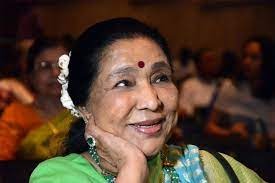In the broad and diverse world of Indian music, one name stands out as a real legend: Asha Bhosle. Asha Bhosle is a multi-talented vocalist with a seductive voice who debuted in the music business at a startlingly early age. At only 10 years old, she made her acting debut in the Marathi song “Chala Chala Nav Bala” from a movie. Unbelievably, at the young age of 16, Asha Bhosle had already recorded her first solo song for the movie “Raat Ki Raani.” The incredible life and musical career of Asha Bhosle, whose name is synonymous with melody and elegance, are extensively explored in this article.
Asha Mangeshkar was born on September 8, 1933, in Sangli, Maharashtra, under the name Asha Bhosle. She was the third of three children, and her family had a long history of music. Her mother Shevanti Mangeshkar and father Dinanath Mangeshkar were both talented vocalists who were also well-known stage performers. The atmosphere Asha was raised in led to the importance of music in her life.
Early musical training was given to Asha Bhosle by her father, who saw her innate gift and began educating her in classical music. She will soon, however, begin an odd voyage in the playback singing business.
Asha Bhosle made her playback singing debut at the young age of 10 by lending her voice to the Marathi movie song “Chala Chala Nav Bala.” This was the beginning of an extraordinary adventure that would span many years and transcend language boundaries.
The formative years of her career were influenced by her elder sister Lata Mangeshkar, who was already well-known as a playback singer. Lata had a big impact on Asha’s career and offered her the chance to show off her skills.
In 1948, Asha Bhosle’s family moved to Mumbai, where there were many chances for young vocalists because to the city’s burgeoning film industry. She struggled in her early years in Mumbai as she tried to establish herself in the competitive playback singing industry.
Asha Bhosle, who was 16 at the time, composed her first solo song for the Marathi film “Raat Ki Raani.” This was a pivotal moment in her career and set her on the path to being one of Bollywood’s most well-known playback singers.
Asha Bhosle’s versatility as a playback vocalist was quickly recognized. She had a unique skill since she could alter her voice to match a range of genres and styles. No matter the style, whether it was classical, folk, jazz, cabaret, or love ballads, Asha Bhosle’s voice flew over every genre with ease.
Some of the most lasting and melodious melodies in Bollywood history were produced as a result of her collaborations with eminent composers like R.D. Burman, S.D. Burman, and O.P. Nayyar. Her flexibility and ability to give any composition life can be heard in songs like “Dum Maro Dum” (Hare Rama Hare Krishna, 1971) and “Piya Tu Ab To Aaja” (Caravan, 1971).
Particularly remarkable is the collaboration between Asha Bhosle and S.D. Burman and his son R.D. Burman. The group’s musical wizardry still has fans in awe today. S.D. Burman’s compositions like “Abhi Na Jao Chhod Kar” (Hum Dono, 1961) and R.D. Burman’s experimental tunes like “Monica, O My Darling” (Caravan, 1971) complemented Asha’s melodic voice.
She worked with O.P. Nayyar on pieces like “Aaiye Meherbaan” (Howrah Bridge, 1958) and “Yeh Hai Reshmi Zulfon Ka Andhera” (Mere Sanam, 1965) that have stood the test of time. These tunes will always have a unique place in the hearts of music fans.
The world of music is renown for the epic duets that Asha Bhosle performed with playback superstars like Manna Dey, Kishore Kumar, and Mohammed Rafi. Her chemistry with these prominent male playback singers led to some of the most lasting songs in Indian cinema.
In songs like “Chura Liya Hai Tumne Jo Dil Ko” (Yaadon Ki Baaraat, 1973) with Mohammed Rafi and “Aap Yahan Aaye Kisliye” (Kal Aaj Aur Kal, 1971) with Kishore Kumar, she was able to harmonize with the male singers.
Over the course of her brilliant career, Asha Bhosle released a number of iconic songs that had a lasting impact on the music industry. Here are a handful of them:
Shikar’s Parde Mein Rehne Do, 1968
In 1981’s “Dil Cheez Kya Hai” (Umrao Jaan),
Ijaazat’s “Mera Kuchh Saamaan” (1987)
Deewana Yeh Mera Dil Pyaar (Don, 1978)
A number of significant medals and prizes, including the Padma Bhushan, the third-highest civilian honor in India, and the National Film Award for Best Female Playback Singer, have been given in recognition of Asha Bhosle’s exceptional contributions to Indian music.
Asha Bhosle was a musical prodigy who excelled outside of the boundaries of Bollywood. She experimented with ghazals, bhajans, and even pop music, showcasing her flexibility further. She has collaborated with artists from other countries, like Boy George and Michael Stipe of R.E.M., demonstrating her capacity to communicate with individuals from many walks of life.
The rise of Asha Bhosle from an unknown playback singer in Marathi film at the age of ten to her current status as a well-known playback vocalist in Bollywood is proof of her unmatched skill, persistence, and unflinching commitment to her profession. Her voice has endeared herself to many generations, and her melodies are still loved by music fans everywhere.
Incalculable contributions to Indian music have been made by Asha Bhosle, whose tunes can elicit a broad spectrum of emotions. She continues to have a storied place in the music business and is hailed as a real diva, whose seductive voice will live on in the hearts of music lovers forever. The legacy of Asha Bhosle not only honors her timeless songs and tremendous skill, but it also serves as a monument to that brilliance.